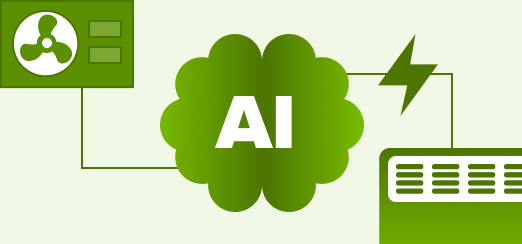
Energy Management for Climate-Controlled Industrial Processes
How deploying digital twins and AI with SoftServe and NVIDIA can help you achieve rapid energy optimization
Elevated energy costs are putting you under pressure to revisit your climate-controlled processes. These notoriously energy-intensive manufacturing operations include vulcanization, thermal food processing, and industrial painting and drying — anything that involves large volumes of conditioned air. The inflated price of kilowatt-hours makes all that heating and humidifying air extremely expensive. A prime target for industrial energy management? That’s easier said than done.
Three problems confront manufacturers looking to reduce the consumption of an energy-intensive climate-controlled process (EICCP). EICCPs are:

Generators of critical production parameters, reducing the scope for experimentation

Frequently governed by legacy technology, which is reliable but inefficient and inflexible

Complex and opaque, making traditional analysis difficult — or impossible
Taken together, that makes for a tall order: Optimizing the consumption of opaque, production-critical EICCPs while working within the confines of existing infrastructure — all without jeopardizing your facility’s output.
EICCPS AND CRITICAL PRODUCTION PARAMETERS
EICCPs are an essential part of a diverse array of manufacturing operations, including:

Rubber vulcanization

Thermal food processing

Industrial-scale painting

Garment dyeing and drying

Paper production

Thermal oxidation
Each of these processes has specific requirements and equipment. For example, while industrial textile production uses drum dryers and steam tables, food processing usually relies on heat exchangers.
THE LEGACY OF INEFFICIENCY IN EICCPS
Many manufacturers use proportional integral derivative (PID) control to govern their EICCPs. They offer reliable setpoints to prevent deviations in air temperature and humidity. But now, greater granularity and dynamism are key.

That’s because the amount of energy required to condition air properly is dependent on its state when it enters the system. As such, the energy consumption of an EICCP is related to variations in the weather. For example, when warmer air enters a heating system, the equipment should not need to work as hard to further increase its temperature.
THE NEED FOR FALLBACKS AND MANEUVERABILITY
Taking advantage of this potential requires finesse. But that can run up against one of your main concerns: reliability. If your equipment overcompensates, it can ruin your goods — a costly mistake.
Importantly, PID control utilizes a fail-safe to guarantee a certain range of temperature and humidity for productive purposes. But its efficiency shortcomings are clear.
LOOKING UNDER THE EICCP HOOD — CONFRONTING COMPLEXITY
That poses a question: Assuming your equipment could deploy energy-optimal settings while guaranteeing your operating windows, would you know what they are — or how to find them?
There are many factors involved in any given EICCP. The temperature and humidity of the intake air may vary widely based on the weather — changing even from hour to hour. That produces a lot of complex dynamics that are difficult to analyze with traditional methods.
On top of that, EICCPs rely on at least two separate machines: one for regulating temperature and one for humidity. Currently, the heat and humidity controllers tend to be reactive, opaque, and siloed operations. That produces a black box and a great deal of inefficiency.
Manually tinkering with these operations would be too complicated, and any intervention would run the risk of disrupting sensitive industrial processes. Yet overcoming this blocker is the key to begin strategically orchestrating the entire climate-controlled process.
LEARNING TO COORDINATE WITH DIGITAL TWINS
The way forward begins with creating a digital twin of the entire air conditioning process and simulating how it relates to the weather. That starts with historical operational data (or simulations) and is then enhanced via a feed of live data from the production facility.

Using a digital twin, you can begin running experiments using neural networks leveraging NVIDIA accelerated computing to speed up the training process. That lets you find the optimal settings of your heating and humidifying equipment given weather conditions and heat recuperation — without interfering with your operations.
DEPLOYING AI FOR OPTIMIZATION
By leveraging your digital twin to build and deploy a machine learning algorithm, you unearth insights that can be used for energy optimization across the entire system.

You do this by training your AI with large volumes of structured data generated by your digital twin on NVIDIA GPUs, using the NVIDIA RAPIDS suite of software libraries included in the NVIDIA AI Enterprise software suite. You deploy those algorithms for inference purposes on an edge AI module from the NVIDIA Jetson family.
For larger deployments, you can add processing power by utilizing the NVIDIA DGX platform. The AI will then make dynamic, proactive recommendations of energy-optimal equipment settings within the parameters determined by your setpoints and given shifting weather conditions.
WHEN IT COMES TO ENERGY EFFICIENCY — THE SKY IS THE LIMIT
By taking advantage of the possibilities offered by digital twins and AI within the context of your existing infrastructure, you can make your energy-intensive climate-controlled process as efficient as possible in record time. As your AI capabilities grow, you will also automate your setpoints with greater frequency for further efficiency gains.
By partnering with SoftServe, you can deploy NVIDIA technology for optimally efficient EICCPs without risk to your operations. That’s because our solution works by building on top of your infrastructure and operations. It does not matter whether you're targeting one thermal process or multiple operations — deployment is fast, efficiency gains are significant, and scaling is easy.
Do you want to go from an opaque, siloed, inefficient EICCP to full visibility and energy-optimal settings in a matter of months?

